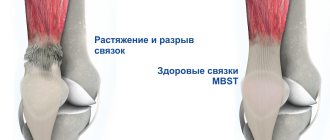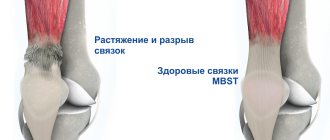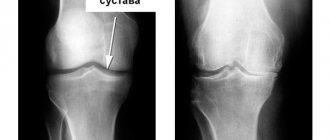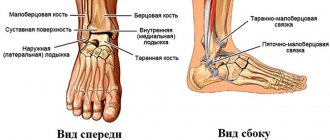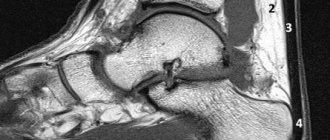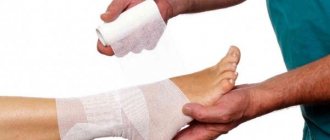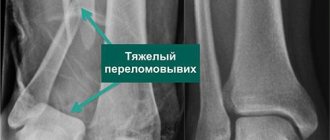To choose an ankle brace, you need to measure the circumference of the ankle joint. Knowing this parameter, you can choose the right bandage: elastic, turbocast or postoperative. The choice of bandages is wide; there are models for recovery after any injury, for playing sports.
It is necessary to know the type of injury, methods of its treatment, personal contraindications, so that the choice falls on the right model. If the clamp is sporty, then it is important to turn on the load level. It is worth taking into account individual characteristics, such as the color of the bandage and its level of visibility to others.
The medical device must comply with its primary function - to support the patient’s joint.
What functions should the bandage correspond to?
Ankle brace
An ankle brace is a device that restrains the ankle joint in the form of an elastic or rigid pad covering the area from the foot to the ankle. The product can perform medical or sports-prophylactic functions:
- fix the ankle under increased load;
- gently limit the ligaments when stretched;
- have a restorative effect after a fracture;
- prevent the joint from popping out of the joint capsule during dislocation.
Depending on the type of bandage, its rigidity increases. The larger it is, the stronger the medical and limiting effect. The patient must understand that soft supports will not help with serious injuries, and those that have hard walls, on the contrary, will lead to them if used against instructions.
It is important to choose an ankle orthosis by size, not just by type.
Content:
- Ankle brace: what is it, types of orthoses
- What materials are used to make ankle braces?
- How to choose the right ankle brace?
- Short description
Ankle injuries occur very often and not only among athletes. These may be dislocations, subluxations, sprains, cracks or fractures. In all these cases, to ensure adequate treatment, a mobilizing bandage called by different terms is used: orthosis, bandage, fixator. A bandage for the ankle joint after a fracture or other injury can be purchased in an online store, pharmacy or specialized departments of orthopedic products. The range of these devices is extremely wide. You will learn how to choose an ankle brace and not make a mistake by reading this publication.
Sports braces
Sports bandage for athletes
A bandage for athletes is selected according to the basic rule: ease of movement. The fixation bandage should not limit or impair movement. It is intended to prevent injuries on the field, not to limit a player's talents.
How to choose an ankle brace yourself?
Depending on the type of sport, you need to choose a specific type of brace.
You can look at the example of the most popular destinations:
- Football. A model of easy fixation made of elastic material is suitable. The best option is to have belts that will allow you to fix the size and change the pressure. Pressing certain points on the ankle not only reduces the risk of injury, but also increases blood circulation, leading to better mobility of the limb. Additional lacing will be a convenient way to fully adjust and fit the ankle size.
- Basketball or volleyball. Both sports are distinguished by the special mobility of the players and the abundance of jumping movements. In order not to reduce the player’s speed and the flexibility of his foot, variations are purchased without the front part and with a hole in the heel area. The best types are neoprene products, which are soft and lightweight. It is necessary to pay special attention to elasticity and check for no skin reactions to the material.
- Martial arts. Cotton overlays with added elastin for improved stretch properties are a popular choice among professionals. Ankle braces for boxing and other types of wrestling do not include forefoot protection.
A coach responsible for the correct equipment for a team or an individual player will help you choose an ankle support for other areas. Before purchasing, you should undergo a mandatory consultation with a person experienced in the field of sports.
Sports models reduce the risk of injury by 50%. This allows you to reduce the turnover of players on the field and improve personal results.
Orthopedics. How to choose the right ankle
An ankle orthosis tightly fits the joint, provides compression and massage effects, protects the joint during sports training, reduces swelling and pain in case of lower leg injuries, after operations, as well as during exacerbation of arthrosis, arthritis, rheumatism and other diseases of the ankle joint.
If the ankle does not provide the proper level of support or is incorrectly sized, it will only delay the healing process and create the preconditions for the injury to reoccur. Therefore, it is important to remember that only a doctor can choose a semi-rigid and rigid orthosis! Independently, without prescription, only ankles with a mild degree of fixation are selected to alleviate the syndromes of arthrosis and arthritis, prevent herbs and reduce pain in the slightest injuries of the lower leg.
Catalog of easy fixation ankles
To determine what kind of ankle orthosis you need and whether you can choose one yourself, you need to determine the severity of the injury. There are three degrees of damage to the articular-ligamentous apparatus of the foot:
- Easy. Signs: no swelling or slight swelling, mild pain, slight limitation of movement, the patient can walk and fully transfer body weight to the injured limb. The recommended type of ankle is an elastic or neoprene ankle, which provides the desired level of compression and does not restrict the movement of the joint. You can choose it yourself!
- Average. Signs: swelling (mild to severe), moderate (tolerable) pain, moderate limitation of movement, difficulty walking and bearing weight on the injured limb. The recommended type of ankle is the ankle, which compresses the joint and provides its fixation with the help of stiffeners. Prescribed by a doctor!
- Heavy. Signs: severe swelling and hematoma, severe pain, complete limitation of movement, the patient cannot bear weight on the injured limb. The recommended type of ankle is ankle, which provides complete immobility of the ankle joint. Prescribed by a doctor!
When choosing an ankle brace with easy fixation, you need to pay attention to the material from which it is made. Ankles with the addition of neoprene retain heat well, provide warmth, accelerate blood flow, and help relieve swelling and pain due to arthrosis, arthritis, and rheumatism. If you have allergic reactions to synthetic fibers or sensitive skin, it is better to choose ankle boots with a high cotton content.
Elastic ankles with silicone inserts provide a little more support and compression, which is important during heavy physical activity and in sports. Also, in order to prevent sports injuries, elastic ankle orthoses with additional Velcro straps have proven themselves well. The main thing to remember when choosing an elastic ankle for sports training is that it must completely encircle the joint on all sides and be high enough.
The size range of ankle feet varies depending on the brand, but in general there are 4 parameters that determine the size of a given orthosis.
- Shoe size;
- Ankle circumference. Measured above the bone at the narrowest part of the ankle;
- Calf circumference. Measured between the knee and ankle (in the middle);
- Ankle circumference through heel. In order to measure this parameter, you need to place your foot firmly on the floor, apply a flexible tape to the edge of the heel and measure the ankle circumference at an angle, as shown in the figure. You need to measure below the bone.
If your parameters are on the border of two sizes, then in the case of the first three parameters you should choose a smaller size, since if you choose a larger size you risk not getting the desired level of compression.
Catalog of easy fixation ankles
Bandage for sprains
Ankle sprain
Signs that indicate mild discomfort in the ankle, heel or foot area allow for independent selection of orthopedic pads. The list of feelings that are a prerequisite for purchase includes:
- absence of swelling when feeling pain;
- slight swelling;
- partial dysfunction of a limb, in which it is still permissible to fully step on the affected leg.
How do you know which model is the best? Lightweight models made of neoprene, elastane, and cotton will cope with the problem. Weak fixation will not limit mobility, but will enhance blood circulation, increase the functionality of the ligaments and eliminate swelling. If a person has suffered a mild muscle (not ligament) sprain, the purchase will compensate for the injury.
Contraindications
The use of an ankle brace for sprains and other minor injuries is permitted. But sometimes the product is contraindicated to be worn on the leg. Patients with skin disorders, including various types of dermatitis, should avoid using fixatives of different hardness. A contraindication is inflammation of the venous wall at the site of contact of the bandage. It is not recommended to use an ankle brace for venous or trophic ulcers that have developed due to diabetes mellitus. If thromboembolic disease develops, it is prohibited to wear a bandage.
Bandages after sprains
Elastic ankle support on the leg
Injuries more serious than bruises and muscle strains require medical attention. He must choose a restraining device. It is advisable to consult an orthopedist. Ankle support, aimed at combating injuries, is sold in specialized orthopedic salons, less often in pharmacies.
With tolerable pain and the presence of a medium-sized tumor, types with medium fixation are acquired. It is imperative to have stiffening ribs that will immobilize the joint or partially limit its mobility to avoid confusion. A medical support will help when the patient is no longer able to fully step on the injured leg.
In conclusion
At the moment, ankle braces are considered effective and reliable in the prevention and treatment of many ailments of joint tissues. A wide selection allows you to choose a product that will ideally suit all parameters. Before starting to use such fixatives, you should definitely visit your doctor. Indeed, in some situations there is a need to apply a plaster cast. It reliably protects damaged joint tissues, muscles and ligaments from further damage due to violations of bed rest. It is for this reason that consultation with a traumatologist is required. Do not forget that an incorrectly selected product can cause serious complications.
Choosing the appearance of the product
Retainers are rarely visible to the human eye. Sports models do not go beyond the shoes and ankles, they are easy to hide with socks, but fixation models for fractures and dislocations often reach almost to the knee. Then when choosing, you should consider:
- presence of straps;
- the presence of lacing;
- model material;
- determining the color of the model.
Standard colors are blue, black and white. It is better not to purchase white and blue for external wear. The most popular option is the black lace-up styles. They are similar in appearance to lace-up leather shoes and can be combined with them. Velcro is less aesthetically pleasing, but more functional and is more often used for fractures.
Correct ankle selection
Back to section The ankle orthosis should fit tightly around the joint, providing massage and compression effects. This ensures protection of joints from increased stress during training, reduction of swelling and pain in case of lower leg injuries, after surgery or as a result of exacerbations of diseases (arthrosis, arthritis, rheumatism, etc.).
If the ankle is the wrong size or is not able to provide the necessary level of support, this will delay recovery and create conditions for the injury to reoccur. You need to know that only a doctor can choose the right rigid or semi-rigid orthosis. You can select on your own only light fixation orthoses, which are used to alleviate conditions with arthrosis and arthritis, prevent injuries and relieve pain from minor injuries of the lower leg.
Before choosing an ankle orthosis yourself, it is necessary to accurately determine the severity of the injury. There are 3 degrees of damage to the joint-ligamentous apparatus of the feet.
- Mild degree, characterized by the fact that the tumor is either absent or there is a slight swelling, the pain is mild, and the limitation of movements is also insignificant. The injured person can walk and put all of their weight on the injured leg. In this case, a neoprene or elastic ankle is recommended, providing the necessary level of compression and not limiting the movement of the joint. For minor injuries, it is permissible to select an orthosis yourself.
- Average degree. Injuries of this type have swelling of varying intensity (from weak to strong), moderate, tolerable pain, and partial limitation of movements. Walking and putting weight on the injured leg are difficult. In these circumstances, an ankle is needed, compressing the joint and ensuring its fixation with stiffening ribs. It must be selected by a doctor.
- Severe degree. It is characterized by tumors of varying volumes, complete limitation of movement, and the inability to bear weight on the injured leg. In these conditions, an ankle stop is recommended that ensures complete immobility of the joint. A doctor should select an orthosis.
When selecting an ankle to eliminate the consequences of a minor injury (light fixation bandage), attention should be paid to its material. Orthoses with the addition of neoprene are good because they warm the leg and retain heat, increase blood flow, help relieve swelling and pain in arthritis, arthrosis, and rheumatism. If you have an allergic reaction to synthetics, as well as with sensitive skin, you should choose ankles with a material that has a high cotton content.
Elastic ankles with silicone inserts have proven themselves to be effective during significant physical activity. They provide slightly greater compression and support for the foot. Elastic orthoses with Velcro straps are useful and convenient as preventive devices for sports activities. The main requirement for an ankle for sports activities is its ability to tightly wrap around the joint on all sides and sufficient height.
Ankle sizes vary somewhat depending on the manufacturer that produces them. But basically they have four parameters that quite fully characterize the size of a particular orthosis.
- shoe size.
- ankle circumference, measured at the narrowest part above the ankle bone.
- shin circumference, which is measured midway between the ankle and knee.
- ankle circumference through heel. To measure this parameter, you need to place your foot on the floor and wrap a flexible measuring tape around your ankle so that the tape passes through the back edge of the heel and wraps around your ankle below the bone - at an angle to the floor.
If the measured parameters turn out to be located on the border of 2 standard sizes, then for the first three you need to choose a smaller standard size in order to ensure the required level of compression.
A few words about proportions
To choose an ankle brace, you need to measure the circumference of the ankle joint. Knowing this parameter, you can choose the right bandage: elastic, turbocast or postoperative. The choice of bandages is wide; there are models for recovery after any injury, for playing sports.
It is necessary to know the type of injury, methods of its treatment, personal contraindications, so that the choice falls on the right model. If the clamp is sporty, then it is important to turn on the load level. It is worth taking into account individual characteristics, such as the color of the bandage and its level of visibility to others.
The medical device must comply with its primary function - to support the patient’s joint.
How to choose the size
The products differ in different volumes in the ankle area. Ankle circumference can be measured at home or with the help of a doctor.
The circumference of the ankle joint should be measured above the ankle bones. In addition, it is calculated:
- ankle circumference;
- ankle circumference;
- foot size (length).
For clamps without heel and toe, such calculations are optional. Comparison of measurements allows you to choose the required size. There are no general standards for bandage dimensions.
When purchasing an orthopedic product, you need to ask the seller for a size chart. It is important to be able to try on the tricwes (caliper) before you buy.
